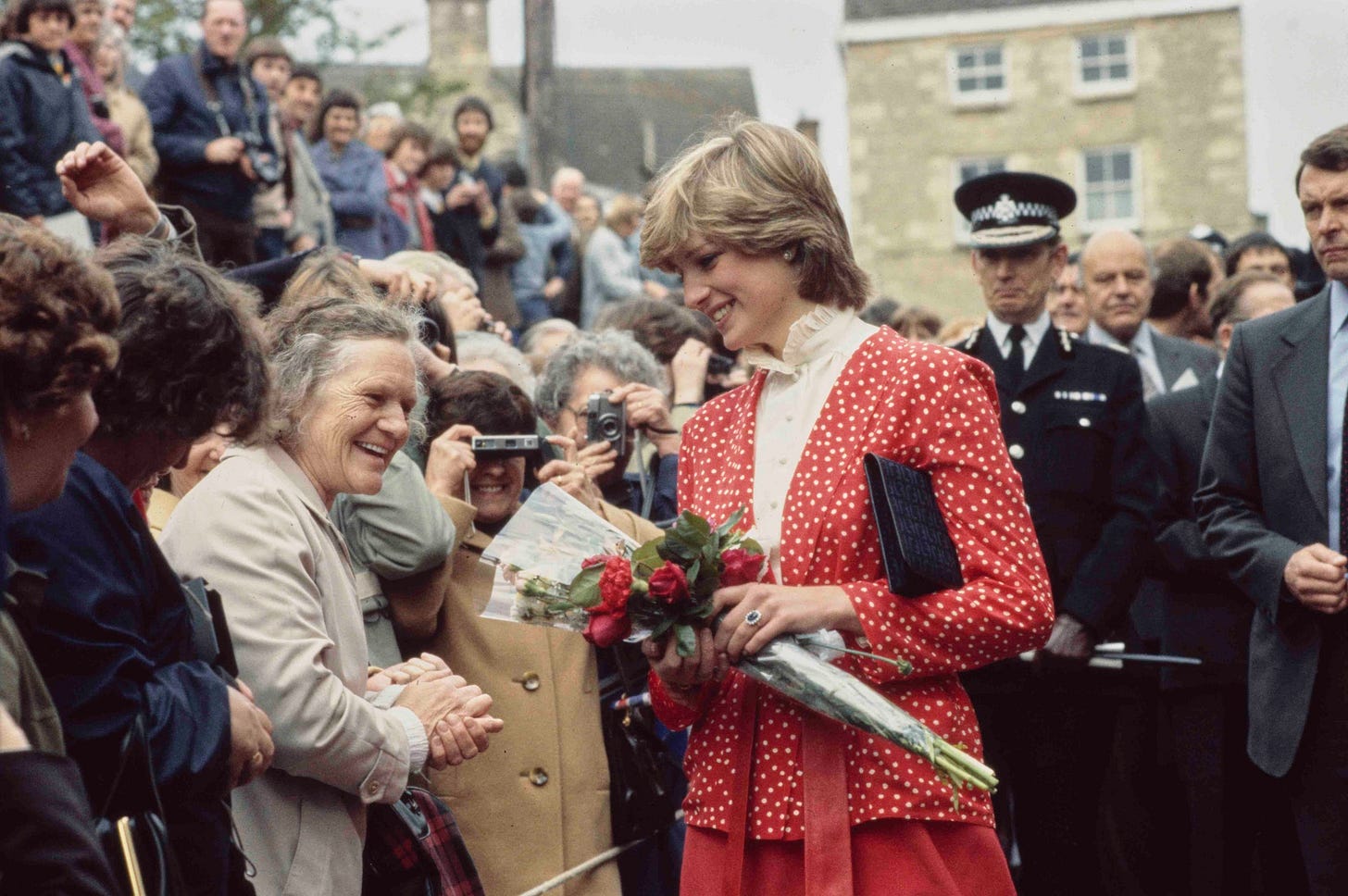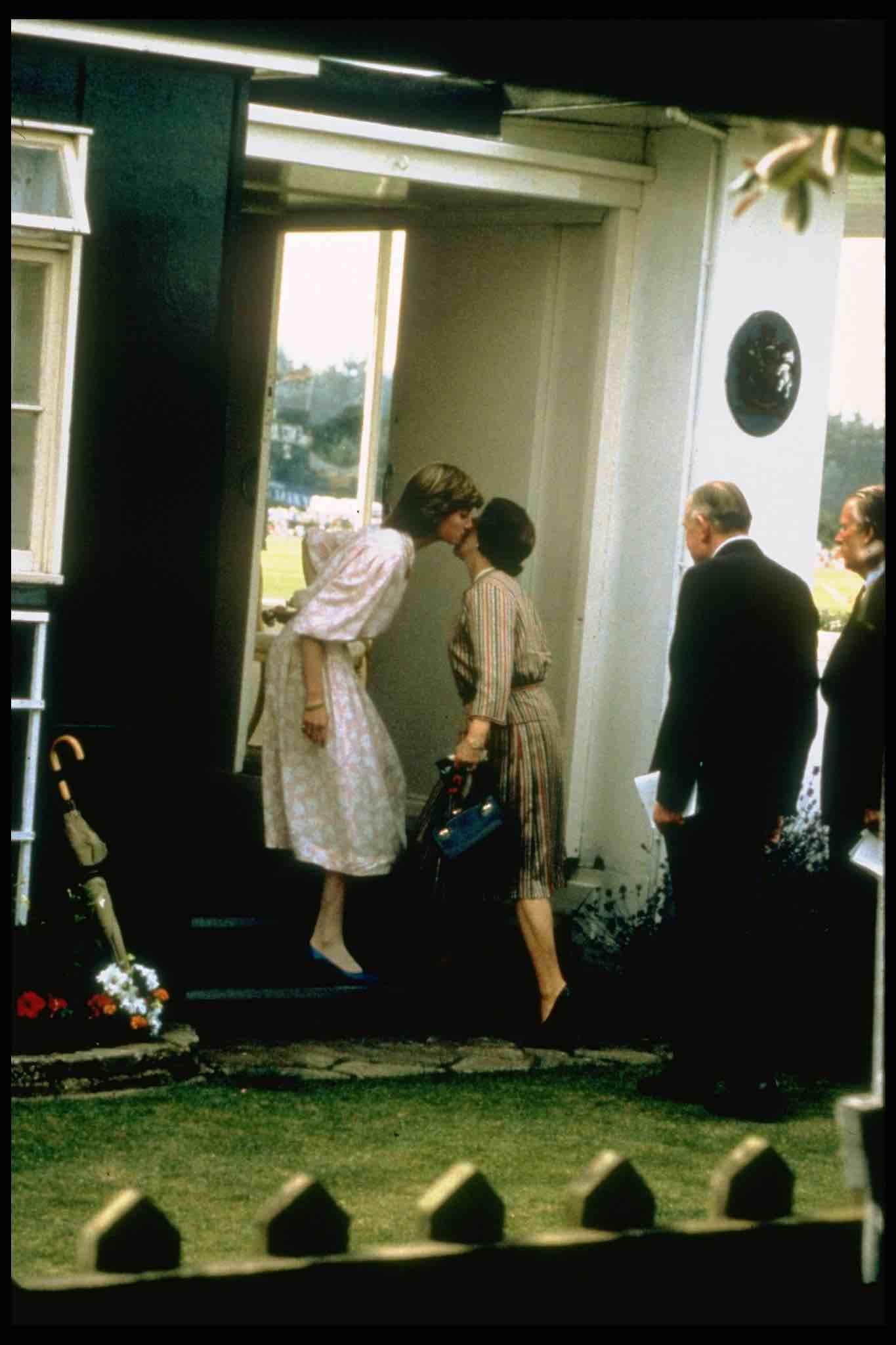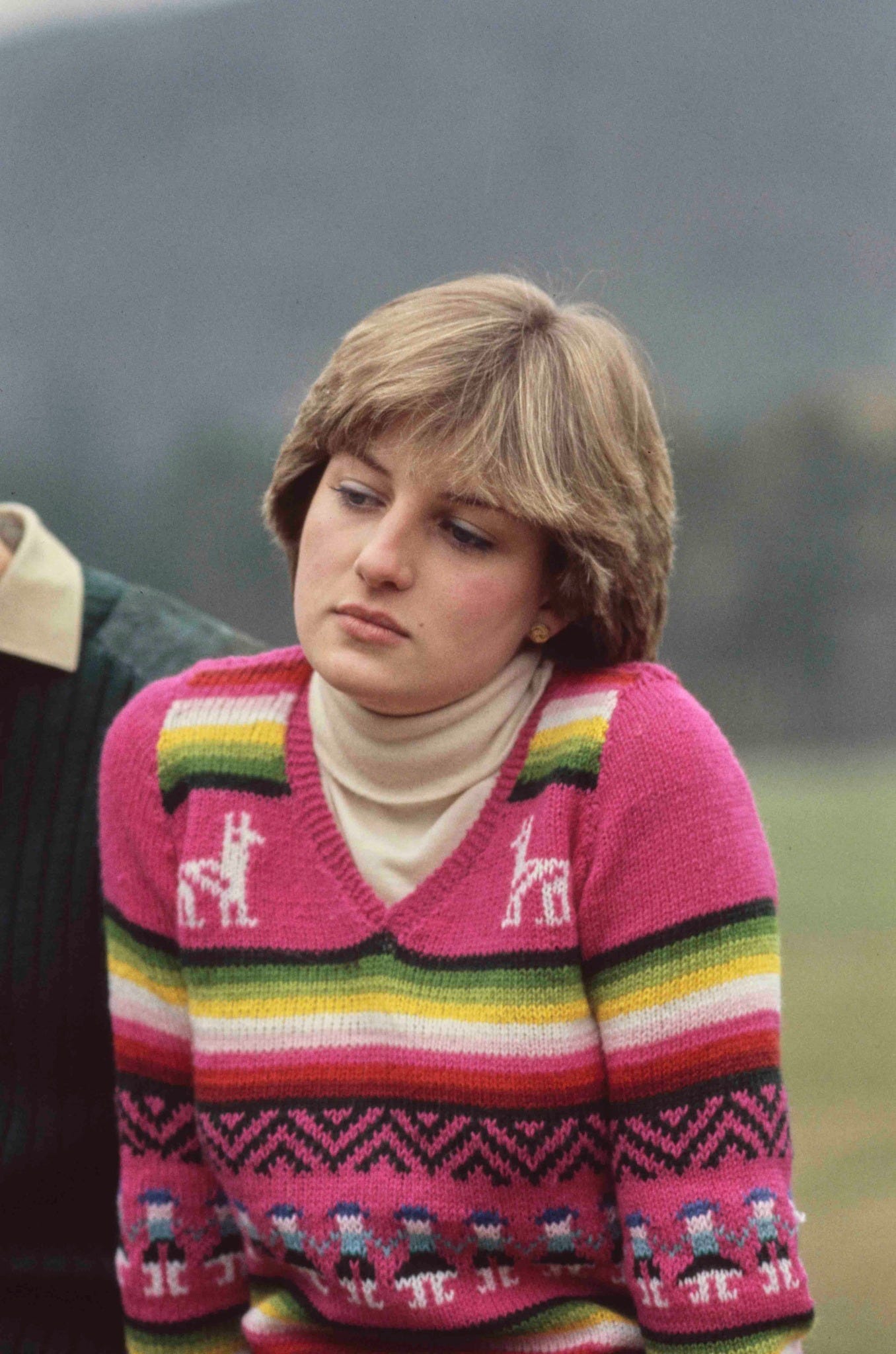Royal Photography Through the Eyes of a Getty Images Curator
Melanie Llewellyn on how royal pictures have evolved and Princess Diana ‘as she’s rarely been seen.’

Welcome to So Many Thoughts, a semi-weekly newsletter about royal style and the other parts of life I want to think through with you. You can subscribe here and follow me on Instagram at @EHolmes. Thank you.
Hello! I hope this finds you enjoying the last stretch of summer. For your weekend reading pleasure, I have a fascinating conversation with Melanie Llewellyn, curator of the Hulton Archive, which is owned by Getty Images and based in the UK. “From historical images created in the early 1800s to more contemporary 1990s imagery, the Getty Images archive houses a wealth of socially significant, historical photos, footage and prints,” she explained to me. It features 80 million analog works, spread across 1,500 collections.
Within the archive there is an impressive array of important royal photographs. I spent hours combing through Getty, both past and present, while putting together my book, HRH. It’s a fascinating way to trace the visual history of the royals—and I jumped at the chance to chat with Melanie about her role.
We talked about how royal photography has evolved, as well as a collection of images Melanie put together of Princess Diana “as she’s rarely been seen.” The context and insight felt delightfully in the spirit of So Many Thoughts; make sure you read to the end for her tip on how to think about royal photographs.
(Our conversation has been edited and condensed for clarity.)
I would love to start by understanding how royal photographs fit into the larger archive.
Melanie Llewellyn: We’ve got this multifaceted portfolio, a survey of royal life from the earliest days of photography. You are charting not only the history of royal photography, but the history of photography itself, all these changing formats.

A carte de visite of Queen Victoria from 1861. (Photo by John Jabez Edwin Mayall/Hulton Archive/Getty Images)
What is one of the earliest forms of royal photography?
A carte de visite was a very popular photographic format from the 19th century. They were these business card-sized photographic portraits, and people could collect them and put them into albums as almost souvenirs. The Victorian royal family were very early adopters of this PR, essentially. We have a set of the very first carte de visites made of the British Royal family and a subsequent series, which were hand-painted and hand-colored (above). We recently loaned a few of those to the Kensington Palace exhibition, Life Through a Royal Lens.
How did royal photography evolve?
When magazines like Picture Post came along, you start moving away from those more formal portraits and you start seeing more of sort of a narrative develop, say for example, the wedding of Princess Elizabeth and Prince Philip.
One of the Picture Post’s photographers, Bert Hardy, was part of the royal pool positioned above the door of Westminster Abbey. Most of the photographers would've had these heavy, static sort of tripod press cameras. One of the sort of hallmarks of Picture Post is that the photographers were using 35 millimeter Leica cameras with roll film. You can snap away and you can get a real story unfolding. But also, just for the agility, he was able to lean over. He created this beautiful shot of Elizabeth’s train.

Princess Elizabeth on her wedding day. (Photo by Bert Hardy/Getty Images)
I think this shot is in my book! [Pause for me flipping to the page and holding it up on Zoom.] Is this it?
Yes, it’s heavenly. It’s magical and ethereal and it says something about the choreography of these events. It just makes it into the dance that it is really.
Where did royal photography go from there?
Then you move into the more paparazzi-esque images. We’ve got a famous one of Princess Margaret just after she had to break off her first engagement. The picture was taken through the glass window, but you can see that there are tears in her eyes, there’s real emotion sort of etched there. That’s more a snatched image.

Princess Margaret in 1955. (Photo by Derek Berwin/Fox Photos/Getty Images)
You curated a fascinating set of images of Princess Diana for the 25th anniversary of her death. Tell me about the process.
At the archive, we have a team who target different areas of the collections and eras in history according to what our customers would be interested in. [We look at] big anniversaries that are coming up, or actually we've talked about The Crown, big pop culture moments. If we expect that the following series is charting this much history, we'd be looking into unseen images there.
Ah, yes, the allure of the unseen. Why are we all so interested in those shots?
There is always something exciting and tantalizing about the unseen and underrepresented. Because how can we make someone like Diana, how can we see her afresh when we do know so much about her life? With time passing and knowledge, it sort of subverts the images themselves.
Images and visuals are a universal language, we perceive them as immediate. But actually, there’s all these layers of context and meaning in there that do sort of change and digress with time passing. The editing process is continual and never-ending because an edit 40 years ago could produce an entirely different result to us looking at the same images today. And that’s not to say the editors 40 years ago weren’t doing their job, it’s just that we're on the lookout perhaps for something different, for an alternative view, a different perspective.

Princess Diana in Oxford, January 1990 (Photo by Jayne Fincher/Princess Diana Archive/Getty Images) From Melanie: “A meet and greet event like so many others, the photographer has lifted an intimate moment from it – a skill shared with Diana herself.”
Let’s talk through a few of these shots. One shot that caught my eye was by Jayne Fincher, one of the few female royal photographers.
I’m always interested in photographer stories because I think that tells us so much about how they’re working behind the lens. Someone like Jayne Fincher, for example, is really interesting; I think she was the only woman working the Royal Rota at that time. And she did develop a rapport with [Diana]. Without wanting to oversimplify it, you do wonder, seeing her being met with a woman’s gaze actually — when you’re in that quite vulnerable situation — would change her demeanor.

Lady Diana Spencer, just before her wedding, kissing her soon-to-be mother-in-law to be in greeting. (Photo by Dirck Halstead/Getty Images) From Melanie: “In a place where each part of a story is told visually, it is the beginnings which often bring the most pleasure, as yet unweighted by history.”
I was also quite moved by the image of Diana giving Queen Elizabeth a kiss on the cheek.
It’s an image that perhaps we wouldn’t have seen, say, a hundred years ago, a stolen moment by an American photojournalist. It offers this different perspective on a very, very photographed subject.
But it stopped me and I think that’s what’s difficult, finding that image that will stop people in their tracks. Seeing that moment of intimacy between these two icons — and that’s such an overused word nowadays, but these two hugely photographed women, very powerful women in both their own ways. And it's this reminder that it was a mother-in-law and a daughter-in-law and that they're a family, and it's a difficult balance.
In light of lots of news that's coming out and obviously there’s [a] huge amount of debate, people are scrutinizing and dissecting a lot of commentary about the family and relationship dynamics. But in that picture — and this is the power of photography — in this one picture, you've got this reminder that they are people at the center of this great narrative.

Lady Diana Spencer in 1980. (Photo by Tom Stoddart/Getty Images) From Melanie: “Acting with exaggerated surprise when her Mini Metro car stalled, the frame is also in contrast to the more troubled, traditional paparazzi images that were to come in later years.”
There is also a delightful shot of Diana making a shocked look at the cameras in her pre-royal days.
Tom Stoddart passed away this year but he was an incredibly talented photojournalist, a press man. He’d been on the front line in conflicts and so it’s kind of unusual for him to be a part of this royal collection that’s curated. But I wonder if there's something almost like street photography — instantaneous, spontaneous — which you’re not, again, perhaps used to seeing with royal photography because the situations and those encounters are rehearsed.
[Diana] was such a visible, recognizable figure, and there are certain faces we’re all familiar with in terms of poses. And so to see this, you almost get a feeling it’s an insight into a person which perhaps people behind closed doors would’ve got to know.

Princess Diana visits a girls' public school near Highgrove, Gloucestershire, in 1985. (Photo by John Downing/Getty Images) From Melanie: “The slightly awkward but swan-like arm reaching out of the car appears to want to escape the formal space of the car, and follow the girl out into the world.”
I’m so curious to hear why you chose to include the shot of Diana reaching out of a car window? It is a fantastic picture but the princess is hardly visible.
[Photographer] John Downing, with his background in photojournalism, is looking for more of a documentary feel and a moment as part of a wider story.
Diana is grabbing hold of this posy, there’s this kind of length she will go to to get this interaction with this child, even [as] the car seems to be moving away. I think says a lot about her. And it’s all power to the photographer that he managed to tell something of his subject without really showing a great deal.
And I love those pictures on the edges almost, those ones that tell what’s going on outside the frame. As a curator, there is great privilege in that. So the frames that are going online are pulled from reams of film, you can see contact sheets. I love seeing those before and after, and we’re starting to see, to delve and resurface a lot more of those now, those frames which for one reason or another were sort of overlooked at the time.

Lady Diana Spencer’s first official photocall with Prince Charles in 1981 after their engagement. (Photo by Tim Graham/Getty Images) From Melanie: “Seemingly showing Diana in a moment of ennui, it may have been overlooked in the initial edit, going against the narrative of an enraptured princess-to-be. As we have come to understand more about her life in subsequent years, the portrait is instead a poignant one.”
What should we be thinking of when we look at photographs?
I always question—and this perhaps shows my era of expertise more than anything—but when the photographer clicks the shutter, why that moment? And always question why. What happened before and after that picture was taken? Because I think we are all quite visually articulate now, but it’s knowing that image is that snapshot.
I think particularly because we’ve moved away from analog photography, where images are taken sort of snap, snap, snap. So it’s kind of a metaphor that’s perhaps being left behind. It’s the great thing about working for the archives is that these images are always relevant. They always tell us something about our present moment.
We can’t be informed about our present without knowing or understanding our past. Always question: Why was that picture taken then in that moment? What was going on either side? What’s going on outside the frame? It’s almost not been consumed by what’s going on in that aperture, thinking of the story. It’s part of what I do in my job really, is telling the story of the before and after as well.

Lady Diana Spencer in London in January 1981. (Photo by Princess Diana Archive/Getty Images) From Melanie: “The same Inca jumper later worn in the Balmoral photocall is seen here in a more urban setting…shows us something of a parallel universe. The future Princess Diana is instead Lady Diana Spencer, nursery school assistant, shown with children in her care at the Young England Kindergarten in Pimlico. The only indication of her fame is that the lady in red is possibly turning towards her.”
My thanks to Melanie! You can find her on Instagram here.
(Header photo by Tim Graham/Getty Images)
The So Many Thoughts Newsletter comes out twice a week. You can subscribe and catch up on the archives here, including:
➡️ How Should We Remember Princess Diana?
➡️ Thoughts on the New Cambridge Portrait from an Art Historian
➡️ Behind the Scenes of Jessica Yellin’s Interview with Meghan, The Duchess of Sussex
💭 Have Thoughts to share? I’d love to hear them! Hit “Join the Discussion” and leave a comment on my Bulletin page. You can also send me an email at Hello@SoManyThoughts.com.



